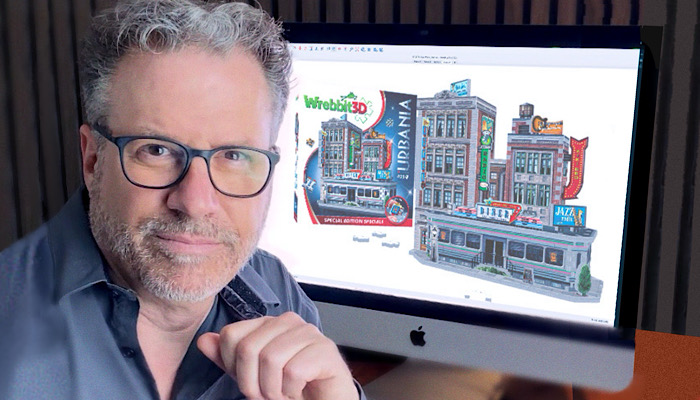—-
To stay in the loop with the latest features, news and interviews from the creative community around licensing, sign up to our weekly newsletter here
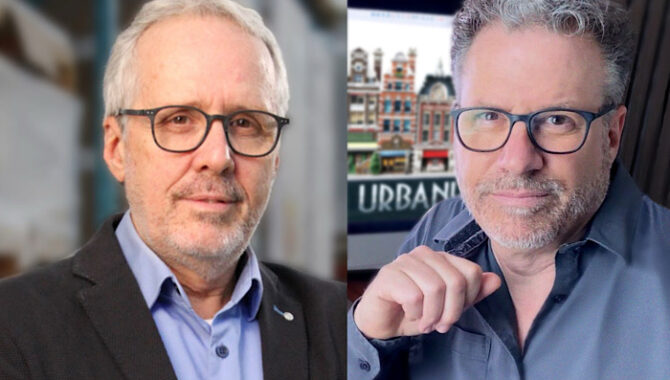
Urbania forever: how a metallic 1950’s diner is changing the face of Wrebbit’s 3D-puzzle town.
Jean Theberge – always a pleasure to see you. We’ve interviewed you a couple of times, of course! People can read your origin story here…
Jean: Thanks for having us back, Deej!
You’re always welcome – I love your products! And Jean-Marc Guérin, this is your first time with this. I understand you’re the driving force behind a new product at Wrebbit, though. Tell me about it!
Jean-Marc: Thank you! Everything here is very much a team effort, of course, but I’m in charge of the development department at Wrebbit. As you know, we have a collection that’s called Urbania. There are four models in it so far: a hotel, a cinema, a café, and a fire station… The idea for that collection came to me around ten years ago when we were coming back from Nuremberg. That’s because – when we go to those show – people are always asking us if we can make the building next to their where they live…
Ha! Just anonymous buildings?
Jean-Marc: Yes, that’s it exactly: we can’t make those because they’re not known around the world. So it came to me that what we have to do is create a village that people feel could be close to the them… Buildings that feel common everywhere in the world. The first four were illustrated by Eric Gallant, who’s the son of Paul, the inventor of 3D puzzle. Since then, they’ve always been my favourite among our products – and I don’t know why, but I’ve always had in mind that it would be great if we had diner! I think because I love this kind of architecture, you know.
Perfect! And I’ll put a photo of the new model, the Diner in here… My only concern being that it’s impossible to do it full justice because there’s no way to show off this beautiful foil printing. How did that come about?
Jean-Marc: We had a meeting with one of the printers we work with. Just out of passion, he was showing me what they can now do with foil. While I was aware of some of those techniques, I didn’t know that it could go that far… The colours were really popping; I was amazed by it. I immediately thought now would be the right time to do a diner with that printing and have the same tinting on the box.
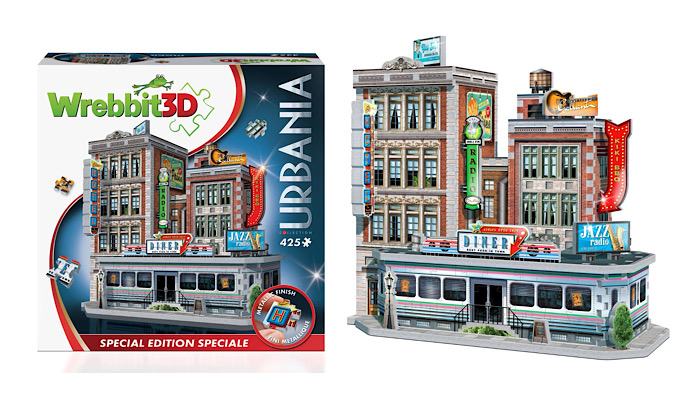
It looks amazing! And does having that foil vastly change the production process?
Jean: No, the printing process is only a little different. At the beginning, we had to wonder: ‘Will our materials cut the same way with the metallic foil on? What if it’s not cut perfectly?’ We had to look into that because it’s easier to tear down if it’s only paper. But we experimented to find out what difference it made to the puzzle pieces. And we were very happy with what we found! We knew we had to do it, and that now is the right time; it’s a great timing for the diner.
And why is now the right time for it?
Jean-Marc: Now’s the right time not only because of the printing process, but also because the world is in difficult times. The diner has that 1950’s vibe, though… People tend to look at that time with nostalgia. They felt a new era was coming; they were excited. And a lot of people feel we need something like that now – just to make our minds dream again. In fact, we did wonder if we should create a new collection that was more focused on retro… In the end, though we choose to put the diner in the Urbania collection because it looks so great when when you put all the models together.
Nostalgia’s not what it used to be though, is it?! But I guess if I’d realized I could print that metallic finish, the temptation would be to do a spaceship or something that’s all shiny… But the diner is very tasteful; it fits in with the collection…
Jean-Marc: Yes, because I had the feeling that if it’s ALL shiny, you lose the interest of it. We need some contrast. So some parts are matt and that helps the shiny parts to pop. In fact, when we were making tests for the puzzle cuts, we had sheets that weren’t printed… they were only shiny. And we realised then that we would need contrast to help tell a story tell a story – because we’re always trying to tell a story with with our puzzles.
And that brings us to the lovely details in the puzzle… Tell me about some of the Easter eggs.
Jean-Marc: Right. We wanted to include some puzzle pieces that, when you find them, give you a feeling… They make you dream or think back, or reflect on the music of the time, say. As this was coming together, I was listening to one of my favourite Canadian singers. As an homage, I just put the name of one of his songs – Kiki BBQ – on the sign here…
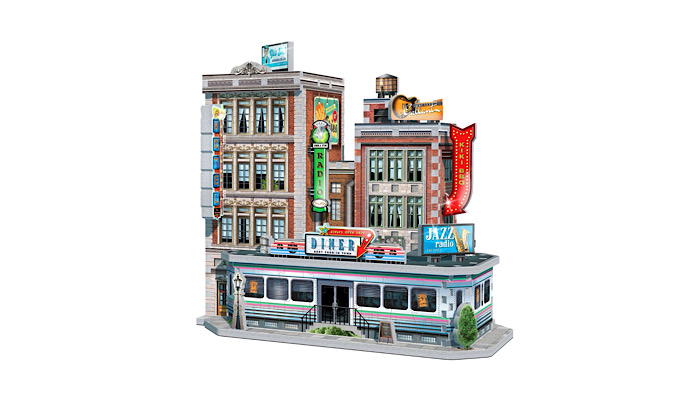
I thought we’d change it later but, in the end, we left it there! Another Easter egg is the sign on top of the puzzle. The founder of the original company, Paul Gallant, was a musician so we put his name over this beautiful guitar to symbolise the music of the time! Also, the radio station has its frequency on this sign is 199.1. That’s because 1991 was the year Wrebbit came to fruition with 3D puzzles.
Oh, I love things like that! You know the two of you just come alive with passion when you talk! I love it. What was the trickiest part of creating this?
Jean: Compared to other product, the trickiest part was, I think, Jean-Marc putting a lot of work into it… But not knowing how it would play in production with the die cut and everything. That was that was the real challenge…
It was a great relief when we we did initial test and found we could use a particular level of pressure on this puzzle to make sure the cut is perfect… This way, when you dismantle the model, everything is fine! There’s no breaking of pieces or what have you. So that was a big concern at first; a tricky challenge, but it worked out beautifully.
And how does that silver end up on the material, Jean? Does it somehow go through a printer twice?
Jean-Marc: No, it’s pretty much the opposite! The board already has the metallic finish on. Then, the printers have eight different colours that we print onto the silver areas we want to eliminate…
Ohhhhhhh! I see! Gosh. That’s amazing!
Jean: With this print, it’s the foil first. Then they print over the foil with all the other colours. And Jean Marc’s twist is that he needed to tone down certain areas of the print so that the foil comes up – or not! It’s pretty difficult.
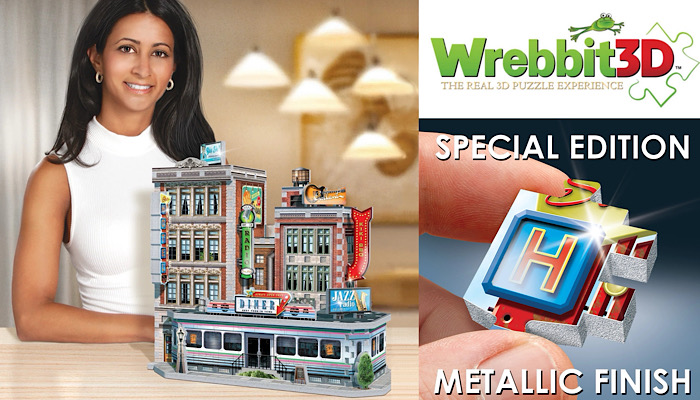
Jean-Marc: I have three different ways to block the foil line. First, I could put a white ink on it. The white ink completely blocks the silver… Then I can print the the colours on it: it’s like printing on a regular paper. Alternatively, I can put down a dark colour… That also blocks the metallic effect. Finally, I have a varnish we can apply. So I have to work out which technique would work best in which area before adding three or four different layers of colour.
Well, you’ve done something there that’s quite beautiful. Tell me Jean-Marc, how did you come to be in the industry?
Jean-Marc: Ah! That’s a fun story… I was actually an independent photographer back then; a commercial photographer. But I had a friend working at Wrebbit. My friend said that the regular photographer was on vacation when they needed a job doing urgently. He asked if I could help with it. And I thought, ‘Why not?’ So I made some pictures – and they never went back to the other guy after that!
Ha! No? So somewhere out there is a chap that used to take the photos wondering how he lost the Wrebbit contract?!
Jean-Marc: Exactly, yes!
Awww! He only went on vacation… 20 years on, he’s still scratching his head!
Jean-Marc: Well, I did the photographs for about five years. The Wrebbit changed ownership when they had their problems. But by that time, it was about 80% of my business… Things slowed down very fast, and – in effect – I was without a job.
Jean: And we talked about those problems, Deej, when we spoke for the first time…
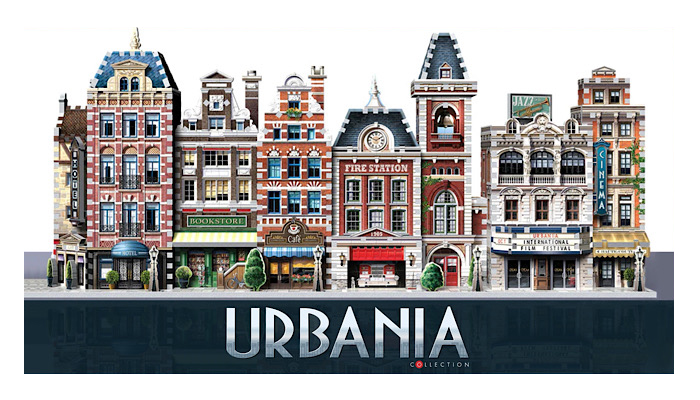
Quite so. Fascinating story. People can read about that here. But when Phoenix, but when Wrebbit rose from the ashes…
Jean-Marc: Then, they called me and said something to the effect that they didn’t need photos, but they needed something done in Photoshop. They knew that I could do that, and they wanted help preparing graphics for the upcoming New York Toy Fair. And they asked if I could come and work with the new team for two weeks.
And you thought, ‘Why not?’!
Jean-Marc: Right! Why not?! I’m free. I went in and I never left since 2000.
My God! So one way or the other, you’ve been doing this for 25 years? Amazing…
Jean: Ha! We wanted Jean-Marc back – so when everybody was telling me I should relaunch Wrebbit, I knocked on his door and the door of a great designer from before… A few people like that. So we joined everyone together. In 2012, we we launched the company together – thirteen thirteen years ago.
Mind you, I don’t suppose he dares take many vacations! But I do love that you put the old team back together. Again, it speaks to your passion.
Jean-Marc: Well, passion is the right word! I still remember the day, 13 years ago, that Jean called me about bringing back Wrebbit. He said he had a project we should chat about. I was so excited to go back to those puzzles! Because the work is interesting, and we have a lot of fun. After twenty five years, I’m still loving my job and loving those projects.
Brilliant.
Jean: And when you mention, Deej, that we’re all passionate about what we’re doing… Well, it’s been like that since 1991. All the people that worked in the former Wrebbit company from 1991 – until 2005; 2006 when it shut down – remember this as a good time. So they were excited when I called people in 2011 and 2012 and said, “You want to go back?” Because they loved wanted to get back into that passion. And that’s been like that for all these years: we’re a very good family, I would say; we’re very tight together…
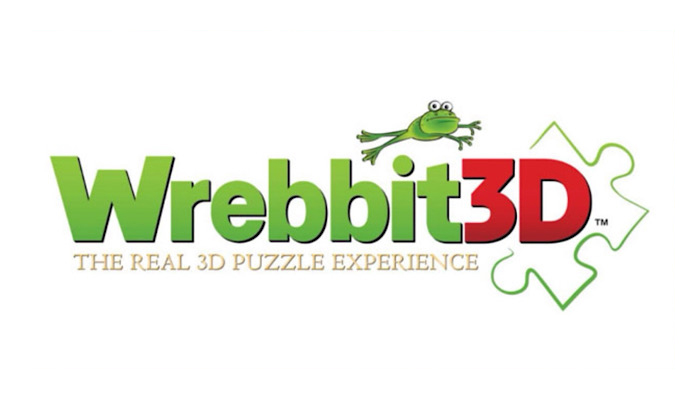
That means we get even get together when times are tougher and remind each other that we’re going to get through it. So it’s not just a job we’re coming to in the morning, doing for the paycheck and that’s it. We’re all into it – and that’s why we celebrate and have some great success in good times, but cope and push on in bad times – because we’re all together.
That’s something a lot of marketing people would have me believe, Jean, but when you say it, I believe it. So! My final question, Jean-Marc, is this: what’s the most interesting object on your desk?
Jean-Marc: Oh! Good question. Hmmm. My computer!
Oh! What a great answer!
Jean-Marc: My computer is a tool I use; it lets me express anything I have in my mind. And, of course, when I first started working, we had no tools that compare to those we have today! But now these tools let me have so much fun with what’s in my brain… My computer allows me to do so many things.
Well, when you put it like that, I wonder why no one’s said it before. Alright! I’m going to link here to a video here to show off the new diner… But let me first thank both of you – what a pleasure to chat.
